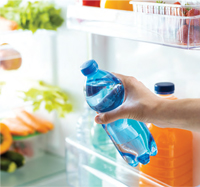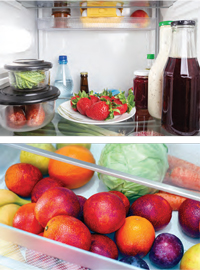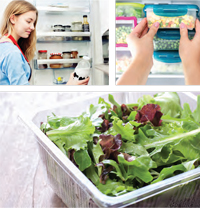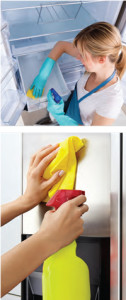Chill Out! | Organizing and Cleaning the Fridge


Open. Close. Open. Close. There probably isn’t a door in our home that gets more of a workout each day than the refrigerator door. But as much as we use it, the fridge— the lifeblood of our kitchens—often becomes the most unappreciated appliance we own. When we close the door, the contents are “out of sight, out of mind,” and we try to forget about attacking the sticky spills and rotting food, not to mention the “lovely” odor combinations.
 Our mothers were right, though: it won’t clean itself. And others likely won’t do it for you, either. Even if you’re fortunate enough to hire a housekeeper, you may be out of luck because many cleaners don’t include fridge services. You should hire a butler if you need someone to manage all your house chores. Like any chore, the longer you neglect it, the harder it will be to get it back under control. And in the case of a refrigerator that stores your body’s fuel, neglecting its cleaning could ultimately affect your health. If you do not like this task, you should hire this End Of Tenancy Cleaning service.
Our mothers were right, though: it won’t clean itself. And others likely won’t do it for you, either. Even if you’re fortunate enough to hire a housekeeper, you may be out of luck because many cleaners don’t include fridge services. You should hire a butler if you need someone to manage all your house chores. Like any chore, the longer you neglect it, the harder it will be to get it back under control. And in the case of a refrigerator that stores your body’s fuel, neglecting its cleaning could ultimately affect your health. If you do not like this task, you should hire this End Of Tenancy Cleaning service.
When it comes to household maintenance, furnace and duct cleaning are often overlooked but essential tasks. Just like the refrigerator that stores our food, the furnace and duct system plays a crucial role in maintaining our indoor comfort and air quality. Regular cleaning not only enhances the efficiency of the system but also contributes to a healthier living environment.
Over time, dust, allergens, and debris accumulate within the ducts, diminishing air quality and potentially aggravating respiratory issues. Addressing this with professional services such as Advanced Cleaning ensures that your home’s air circulation remains clean and optimal, reducing the risk of health concerns associated with poor indoor air quality. Advanced Cleaning specializes in comprehensive furnace and duct cleaning services, employing advanced techniques to remove built-up contaminants effectively. By investing in regular maintenance, homeowners can prevent issues such as reduced airflow, inefficiency, and even potential fire hazards caused by excessive dust accumulation.
Just as neglecting refrigerator cleaning impacts food hygiene, overlooking furnace and duct maintenance can lead to compromised indoor air quality and increased energy consumption. Entrusting these tasks to professional not only ensures thorough cleanliness but also peace of mind, knowing that your home’s heating and ventilation systems are in top condition for the comfort and well-being of your family.
The tips below will help your family store food properly and stick to a cleaning regimen. Because there’s not a more welcome sight to behold at midnight than a clean refrigerator stocked with just what you need to stave off that late-night craving. You can get all the help you are missing for cleaning by checking out this resources.
Indeed, maintaining a clean and organized refrigerator is not only about aesthetics but also about ensuring the health and safety of your household. As our mothers wisely taught us, regular cleaning is key to preventing foodborne illnesses and maintaining the freshness of your stored items. However, tackling this chore can be daunting, especially if it has been neglected for some time. That’s where having the right tools, like sturdy rubber gloves, can make a significant difference in both efficiency and safety. When handling potentially messy or grimy surfaces, protecting your hands with quality gloves from https://buygloves.com not only shields you from harmful bacteria and chemicals but also provides the grip and dexterity needed to tackle the task effectively. Whether you’re wiping down shelves, scrubbing away spills, or disposing of expired items, wearing gloves while cleaning your refrigerator is a simple yet crucial safety measure.
 Order up some order
Order up some order
I don’t know about your family, but in my household, piles of randomness develop when items aren’t returned to their rightful homes. At the bottom of the pile are useful items, of course, but they’re just hidden (or “lost” as my children would say). That’s the same case in our refrigerator. Someone will yell, “We’re out of ketchup!” and then off to the store we head, only to find out when I clean the fridge a week later that we’ve been hoarding five bottles. Sound familiar?
Believe it or not, refrigerator designers did have a purpose in mind. Whether you have a basic or deluxe model, there are spaces created specifically for certain types of food. Stick to keeping foods where they belong, and you won’t be throwing out containers of expired or rotten food on a steady basis. Even by making use of the drawers and shelves you already have, it is worth checking out the new storage bins and containers available in the housewares aisle. Manufacturers know that the refrigerator is a hot spot for disorganization, and have created bins in all sizes marketed for refrigerator use. Many are clear and come with labels so you can keep smaller items like yogurt cups, soda cans and those popular sauce packets from your favorite restaurant from getting pushed around and falling between larger items. It’s also a good idea to walk down the bath aisle too—the baskets with suction cups for your shower are useful for stashing grab-and-go snacks for the kids, such as cheese sticks.
One hard and fast rule in food storage is to place your raw meats on the lower shelves and your ready-to-eat and already cooked foods on the top, so there is less chance of them dripping and contaminating other foods. Always remember that the door is naturally warmer, so place eggs and egg products on the shelves.
Everyone knows that crispers—the bottom drawers—are meant for fresh produce, but few people know how to use them properly. The humidity controls are there for a reason. Most models have two drawers, so set one to low and one to high. Basically what you’re doing is opening or closing a vent in the drawers to either retain the cold air and moisture (closing it for high humidity) or to allow more airflow (opening it for low humidity). Low-humidity foods are generally foods that tend to rot faster; they need more air circulation. A general rule of thumb is to place fruits in low humidity and vegetables in high humidity. (For a handy list of which produce to place where, visit thekitchn.com.) Trust me, using your crispers the right way will extend the life of your food and cut down on food waste, and the guilt that comes with it!
Grouping items is a must for organization, but quantity matters, too. Refrigeration relies on good air circulation, so don’t crowd the shelves. Freezers shouldn’t be compacted either, because air circulates from the freezer to the refrigerator; packing the freezer tightly can cause your fridge to run poorly. If you find yourself creatively stacking products to fit them in, that’s a sure sign you need to get rid of some of your inventory. (Crisper drawers are fine to pack half full, but beware of placing the heavier foods on top of the lighter and softer ones).
I use small bins in my freezer to help with organization, too. I have one for grab-and-go items like frozen waffles and ice cream treats, and ones for frozen vegetables and frozen meats. It helps me to see what I have so I don’t purchase unnecessary items.
 Safe storage
Safe storage
I’m sort of a geek when it comes to knowing how long food can be stored in my refrigerator and freezer. I keep a bookmark on my cell phone’s browser to a storage chart from the Food and Drug Administration (fda.gov/media/74435/download). The chart is mainly for meats and egg products. Raw hamburger, for instance, a staple in our house, can be stored in the refrigerator for up to two days and the freezer for up to four months. If keeping meats in the freezer longer than two months, the FDA recommends that you wrap it in extra airtight plastic wrap, foil, or freezer paper or place in a plastic bag. Opened packages of luncheon meats should be kept no longer than five days in the fridge and two months in the freezer.
The FDA site also offers lots of tips for properly storing food to prevent foodborne illnesses, such as:
- Put refrigerated and freezer items away as soon as possible after bringing them home. (Check the labels to make sure that refrigeration is required). The “two-hour rule” is appropriate for items that are left out at room temperature. That also means leftovers and take-out foods.
- Keep the refrigerator temperature at or below 40° F (4° C) and the freezer temperature at 0° F (-18° C) and check the temperatures periodically. (Buy an appliance thermometer at any hardware or big box store; many cost less than $15.)
- Throw out any food that looks or smells suspicious. Discard all food that is moldy.
- Keep foods covered at all times. Use covered containers or sealed storage bags, and check leftovers daily for spoilage.
To keep my fridge from getting out of hand, I set aside the same day each week to sort through expired food and assess the life expectancy of leftovers. (I’m not lucky enough to have a garbage disposal, so I do this deed the night before garbage collection day, so I can take the trash right out to the curb). Refrigerator Repair In Oceanside repaired my refrigerator and it is like new again. You may also contact a home appliance repair service in your area that can provide sub zero refrigerator repair services if you encounter issues with your refrigerator.
 Sanitize and deodorize
Sanitize and deodorize
Wiping down all surfaces regularly can help keep bacteria at bay. But every couple months, a thorough cleaning is needed. Again, refrigerator designers know what a hassle this can be, so they’ve made the shelves easily removable. I like doing a sorting/tossing blitz in one day and then tackling the shelves and drawers over a few nights. This way, I can still keep food in the refrigerator; I just move it to the side I’m not cleaning.
Just a small amount of dish detergent and water can usually do the job. I’ve found that the bathtub is the best place to scrub the entire shelf and rinse it thoroughly. Before placing shelves back in the fridge, I use detergent and water again to wipe down the walls.
The best way to fend off stuck-on mess is to clean up spills immediately—even if it’s just wiping with a wet rag or paper towel, then cleaning with detergent when you have more time later in the day.
Don’t forget the seals around the door, and also the door handle, which can easily become one of grimiest places on your entire fridge. I’ve even seen people use whitening toothpaste on a toothbrush to get in the crevice of the seals (if you do this, make sure you wipe down with soap and water afterward).
Baking soda is still the natural deodorizer of choice; mix ¼ cup with 1 quart of warm water to wipe down everything. Place an opened box in the back of your fridge to cut down on odors.
The invention of refrigeration greatly transformed kitchens in the early 1800s. Today, I’m afraid, like many modern appliances, we take it for granted. The refrigerator deserves our respect every day, and our health depends on it. Cut down on food waste and prevent illness by storing your food properly and safely. And if your family could use a reminder every now and then to help keep the refrigerator clean, maybe you could post this article where it is most likely to be seen—say, like, hmmm, maybe the refrigerator door? ✦
baking soda, crispers, deodorize, food storage, foodborne illnesses, fresh produce, high humidity, improve, Low-humidity foods, Organizing and Cleaning the Fridge, raw meats, refrigerator, Safe storage, Sanitize






